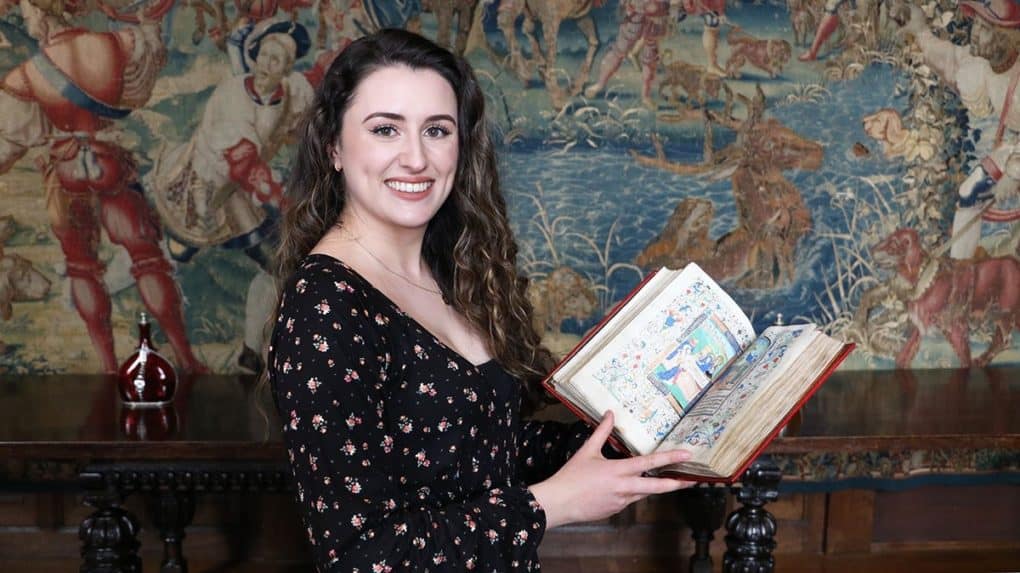
On the anniversary of Anne Boleyn’s execution (19 May), Hever Castle announces research conducted into an Anne Boleyn prayer book on display in her childhood home has revealed never seen before names and words hidden in the pages of the historic Book of Hours volume.
Using ultraviolet light and photo editing software it has been discovered what happened to the volume after Anne was executed on 19 May 1536 and when legend has it she handed the book to one of her ladies.
Former Hever Castle steward Kate McCaffrey spent nearly a year studying the two prayer books and discovered wording in the printed Book of Hours which had been undiscovered for hundreds of years.
Following the demise of Anne Boleyn, despite pressure to remove all items belonging to the former Queen, the prayer book she is believed to taken to her execution still survives.
And why this beautifully illustrated prayer book survives was revealed in Kate’s research, part of her thesis for her Masters in Medieval and Early Modern Studies at the University of Kent.
Kate, who worked at Hever Castle as a Visitor Experience Assistant for about six years, was given special permission to look into the prayer books which previously was thought only to contain one inscription.
Using ultraviolet light and photo editing software she discovered three family names written in the book; Gage, West, and Shirley (from Sundridge, near Sevenoaks). These three names centre around a fourth, the Guildford family of Cranbrook in Kent.
Kate’s research uncovered that the book was passed from female to female, of families not only local to the Boleyn family at Hever but also connected by kin.
She explained: “It is clear that this book was passed between a network of trusted connections, from daughter to mother, from sister to niece. If the book had fallen into other hands, questions almost certainly would have been raised over the remaining presence of Anne’s signature. Instead, the book was passed carefully between a group of primarily women who were both entrusted to guard Anne’s note and encouraged to add their own.
“In a world with very limited opportunities for women to engage with religion and literature, the simple act of marking this Hours and keeping the secret of its most famous user, was one small way to generate a sense of community and expression.”
She added: “It was incredibly exciting and surreal to uncover these erased inscriptions, and it has been an absolute privilege to restore the names of their authors and recover their stories. What is perhaps most remarkable is that these inscriptions have been unknown and unstudied for so long.”
Dr David Rundle, Kate’s supervisor said: “It is every graduate student’s dream to uncover previously hidden information about a well-known historical figure. Kate’s energy and enterprise have allowed her to do just that, even in the depths of the pandemic when libraries were out of all researchers’ reach. What she has discovered has potentially highly significant implications for our understanding of Anne Boleyn and her posthumous reputation.”
Hever Castle has on display two illuminated Book of Hours prayerbooks, belonging to Anne Boleyn which she had written in and which bear her signature.
The book, which she may have taken to her execution, bears the touching inscription, ‘remember me when you do pray, that hope dothe led from day to day’.
Only a handful of Anne’s books survive today and only three contain her signed inscriptions. One is held at the British Library, the other two at Hever.
Kate also discovered as part of her research that a copy of the printed Book of Hours in the Morgan Library in New York belonged to Anne’s greatest rival in power and love, the Queen of England, Catherine of Aragon.
Book your visit to Hever Castle & Gardens.
Within the grounds of the Hever Castle Estate, there are two opportunities for you to stay the night with us.
Hever Castle has played host to many important events and celebrations for over 600 years. In 1903 when William Waldorf Astor set about restoring Hever Castle to its former glory, he added the Astor Wing, to accommodate his family and guests, before creating a lake and the spectacular Italian Garden to house his impressive collection of ancient Greek and Roman statuary.
There are multiple places to eat & drink across the Hever Castle Estate. Select between the Castle & Gardens and Golf Club below to discover more.
Set in the mature grounds of the Hever Castle Estate, Hever Castle Golf Club is a 27 hole Kent golf course that will encourage and inspire all golf enthusiasts.
Set in the mature grounds of the Hever Castle Estate, the Wellbeing Centre consists of five smart treatment rooms.